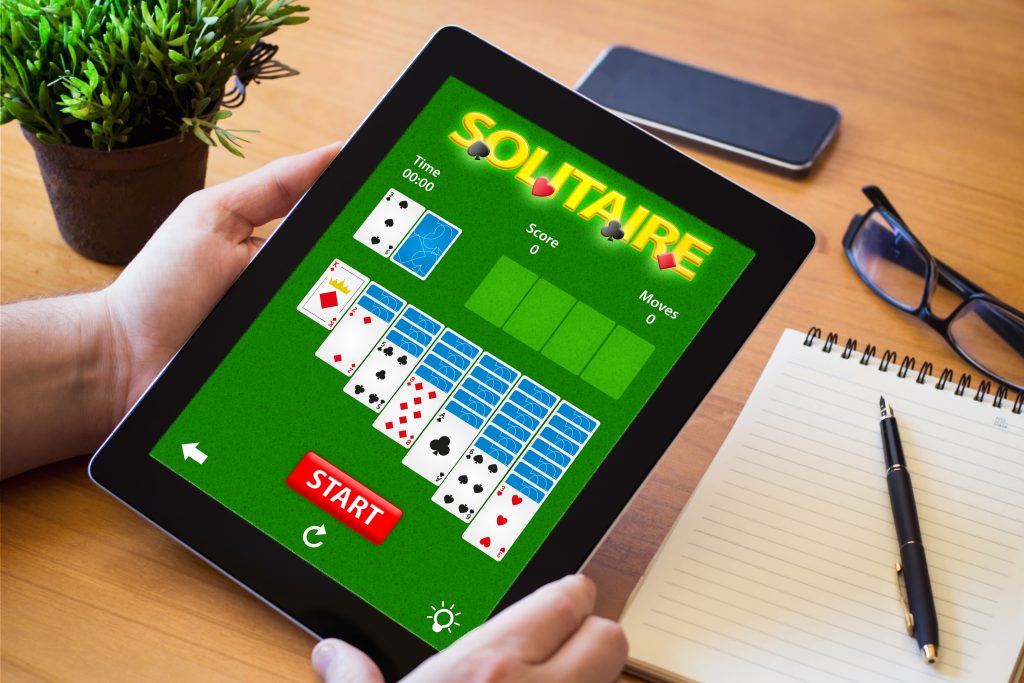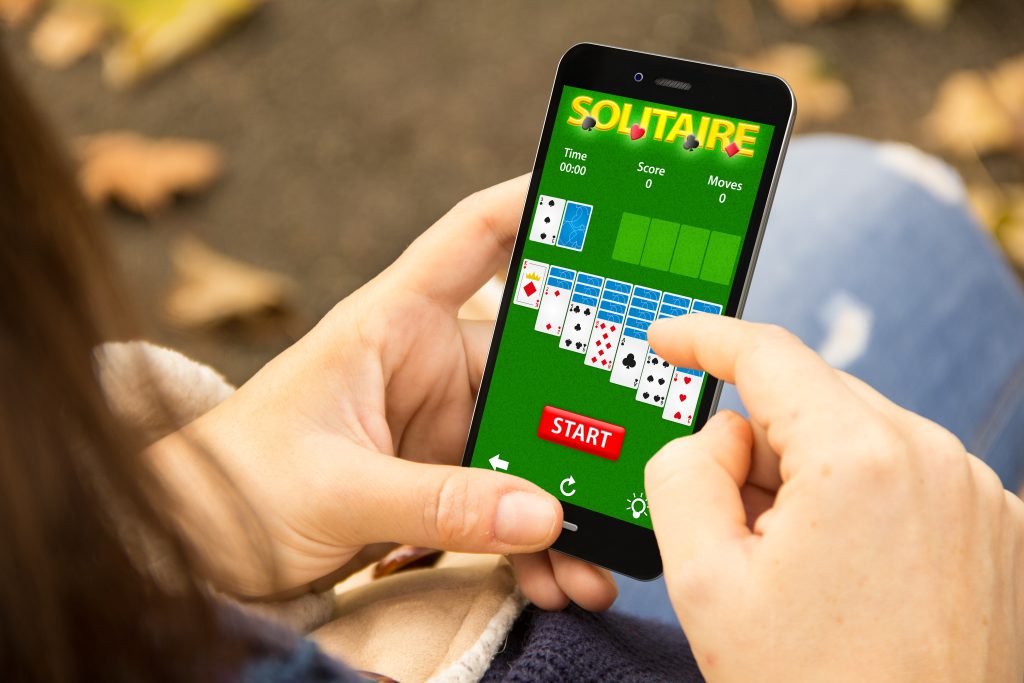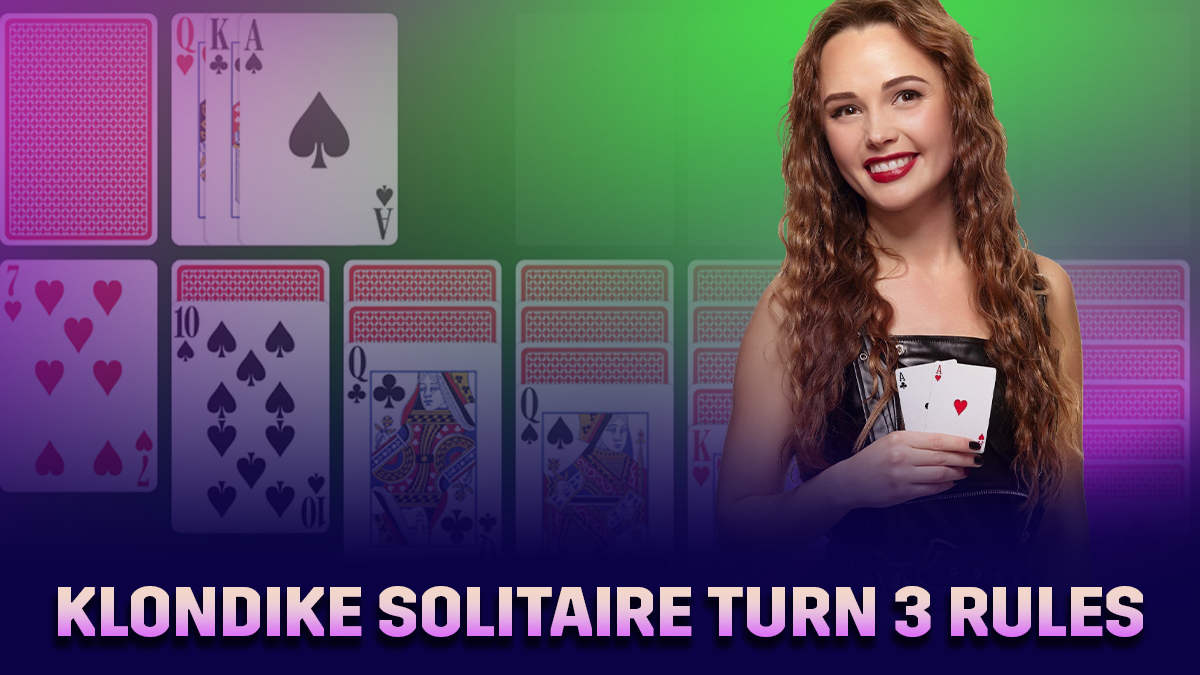Table of Contents
ToggleKlondike Solitaire can be made challenging enough. However, experienced players might find the classic solitaire game less challenging. For those players, Klondike Solitaire Turn 3 comes across as a tough game with multifaceted challenges and strategy. It adds more complexity and intricacy to the game.
Let’s understand what the Klondike Solitaire Three Turn game is and how to play Solitaire Turn 3.
What is Klondike Solitaire Turn 3

Source: McLittle Stock /shutterstock
Klondike Solitaire Turn 3 is just like the normal Klondike Solitaire (also known as Klondike Solitaire Turn 1) in terms of objective and gameplay. However, you have to draw three cards at once from the stockpile, unlike the one-card in Turn 1. Once drawn, you can play only the top of the three cards. Then, you can go for the next card in the three cards already drawn.
Klondike Solitaire Turn-three is also known as three-card solitaire. The number of moves is curtailed in Turn 3, adding to an increased challenge. It is said that theoretically, only 79% are winnable in Klondike Solitaire Three Turn.
How to Play Klondike Solitaire Turn 3
The rules of Klondike Solitaire Three Turn may not pose difficulty for experienced players; they may not have to learn. However, beginners need to spend some time learning how to play Solitaire Turn 3.
Objective
The goal is to organize all the cards into four foundation piles: one foundation pile for each suit, starting with the Ace and building up to the King.
Setup

Source: McLittle Stock /shutterstock
In Klondike Solitaire Three Turn, a standard deck of 52 cards is used. The game starts with arranging seven tableau columns. 28 cards are arranged in these 7 columns, in descending order. The first column has one card, the second column has two cards, and so on, with only the top card in each column face-up. The rest of the cards form the stockpile.
When you want to draw or reveal cards from a stockpile, the cards will form another pile known as a waste pile or discard pile. After all the cards from the stockpile have been drawn, any remaining cards in the waste pile that haven’t been moved to the tableau or foundation can be reshuffled and redrawn in the same order from the stockpile.
There is a space for four foundation piles where you arrange cards of each suit, from Ace to King.
Here are Different Types of Solitaire Games You Must Know About!
Solitaire Turn 3 Rules
- Only face-up cards can be moved; face-down cards must be revealed by clearing cards above them. (In some variations, you may be unable to undo moves, increasing the challenge.)
- A card can be moved onto another card of the opposite color and one rank higher (e.g., a Red 6 on a Black 7).
- Cards of the same suit are required to fill any foundation pile in three-card solitaire.
- In standard solitaire, cards from the stockpile move to the waste pile, and the stockpile can be refilled from waste when empty with an unlimited number of passes. However, the number of times you can do this is limited in some variants.
- Only a king can fill empty piles in tableau columns, helping with rearrangement and unlocking further moves.
- The topmost card from the waste pile can be moved to the tableau if it’s an allowed move (one rank lower and opposite suit or a King to an empty pile).
- Individual or stacked cards in the tableau can be moved onto a card of an alternate color and higher rank.
- Strategic movement of cards between tableau columns can help uncover face-down cards and create empty spaces for Kings.
- Cards must be moved to the foundation starting with an Ace and followed in a built-in sequence by suit from Ace to King.
Some versions of the Klondike Solitaire Turn 3 keep track of the time it takes to complete a game.
Winning
The game is won when all four foundations, from Ace to King, in all four suits, are fully built. The arrangement follows ascending order.
Strategies to Win Solitaire Three-Turn
Learning the best strategies simplifies gameplay for beginners, allowing them to master the Klondike Solitaire Three Turn quickly.
Use Stock Carefully
Make use of stock only when no more valuable moves can be made in the tableau. While not every possible move must be made, the card should likely be played if no strong reason exists to hold back.
One or Two Ace in Foundation
It is good to place one or two Ace cards in the Foundation piles if possible. But if you find them in the Waste pile, beware. Moving cards from the Waste pile constantly changes the order of cards in the stockpile after initialization for any card.
Moving to the Foundation
You can safely move any card from Tableau to the Foundation as long as both lower-ranked cards of the opposite color are already in the Foundation. For instance, if the ♦5 and ♥5 are in the Foundation, it’s also safe to place the ♠5 there.
Start by Revealing the Larger Tableau Piles
The goal of Solitaire is always to reveal the most valuable cards. In tableau piles, the last two columns hold the largest number of unrevealed cards, with maximum chances of finding the desired card. So, a blind rule is to focus on revealing the larger tableau piles first. Deal with shorter tableau columns in the later part of the game, as they have less number of cards. Meanwhile, you could have solved most of the game as well.
Don’t hesitate to Pull from the Foundation Pile
You might have lined up cards in the foundation pile already. But that shouldn’t be a matter of security! If you can’t move the tableau, try getting a card back from the foundation pile if that helps. Say you have 6♥ in the foundation and 7♥ in the tableau needs a 5♥. Move 6♥ back to the tableau, creating a sequence that frees up blocked cards.
Try to Clear a Tableau Column if there is a King
If you have a King in a tableau pile, try to clear that column by shifting them to empty columns. Only Kings can be moved into empty columns. For example, you have K♠, Q♥, J♦ in a column blocking useful cards below. Move this sequence to help you access the hidden card underneath.
A general rule in Klondike Solitaire is to move cards within the tableau piles rather than from the waste pile.
While it’s usually wise to reveal a hidden card when possible, it is not always true. For instance, uncovering the hidden card might require moving a risky card to the Foundation, which could complicate the game.
How to Play Klondike Solitaire Turn 3 Online
Klondike Solitaire Turn 3 is a solo game as such. The online gameplay involves a few instructions on how you can achieve various moves:
- Drag and drop the desired card using the mouse to move cards between different piles. The foundation piles are arranged in the upper left corner.
- If you want to draw cards from stock, just click on the stockpile. Reshuffling naturally happens when the stockpile is empty and cards from the waste pile are moved to the stockpile.
- You can drag a card from Tableau to add it to foundation piles, or you can double-click it to do the same.
- Some online games use timers to add further challenges.
Klondike Solitaire Turn 3 vs Klondike Solitaire Turn 1
Three Card Solitaire is more challenging than Turn 1 due to the restriction of playing only every third card from the stockpile. This limitation forces players to think ahead and plan their moves strategically, as fewer playable cards are available at a time. In contrast, Turn 1 allows players to play every card from the stockpile, providing more flexibility and straightforward gameplay.
The difficulty of Klondike Solitaire Turn 3 appeals to more advanced players who enjoy a more significant challenge. Klondike Turn 1 is more beginner-friendly, with more options for card movement and a higher win rate.
Read More: Top 12 Solitaire Games That Pay Real Money
Conclusion
Due to its restricted card access,Klondike Solitaire Turn 3 pushes players to develop advanced problem-solving skills and foresight. It is a more strategic version of the classic game. Playing three-card solitaire can also improve cognitive functions such as memory retention and decision-making under pressure. This added complexity suits players looking to improve their mental agility and enjoyment.
FAQs
Is Klondike solitaire turn 3 difficult to learn?
Three Card Solitaire is not difficult to learn, but it requires more strategy than Turn 1 due to the restriction of only playing every third card from the stockpile. Beginners can grasp the basic rules quickly, but mastering the game and consistently winning takes practice and patience.
Is Klondike solitaire turn 3 good for your brain?
Yes, Three Card Solitaire can be good for your brain. It promotes critical thinking, problem-solving, and memory skills by requiring players to strategize and plan moves. The game also improves concentration and patience. It offers useful mental exercise along with fun and engaging challenges.
What is the success rate of Klondike solitaire turn 3?
Three Card Solitaire is considered moderately challenging. In a study of 1,429,916 random games, only 158,382 were won, giving it a win rate of 11.1%. This is more difficult than Turn 1, which has a higher win rate of 33.0%.
Where can I play Klondike Solitaire Turn 3 online for free?
There are several websites where you can play Solitaire Turn 3 for free. For example, you might try Solitairebliss.com, Solitaired, Solitaire.net, etc. Alternatively, see if free mobile apps are available on Google Play store or Apple Store and download them.








